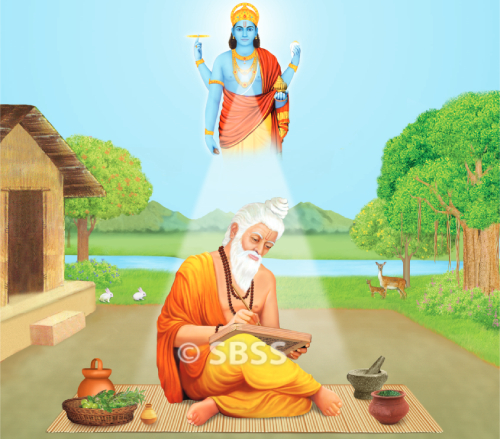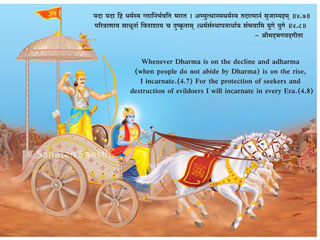Ayurveda for a healthy life ! – 3/2023
Importance of good health as per Ayurveda

1. What is the composition of the human body ?
The important elements, which form the basic constituents of the human body, are given ahead.
| Element | Proportion (%) | Element | Proportion (%) |
| 1. Oxygen | 65 | 7. Chlorine | 0.18 |
| 2. Carbon | 19 | 8. Sulphur | 0.15 |
| 3. Hydrogen | 8 | 9. Sodium | 0.1 |
| 4. Nitrogen | 3 | 10. Potassium | 0.1 |
| 5. Calcium | 2.5 | 11. Magnesium | 0.06 |
| 6. Phosphorus | 1 | 12. Iron | 0.01 |
Manganese, copper, iodine, zinc, cobalt, molybdenum, silicon, fluorine, aluminium, nickel, chromium, titanium, arsenic, selenium, barium and strontium are found in a very small quantity, i.e., in milligrams and are known as trace elements. These basic elements are used to form the building material of the body.
2. What are the functions of these basic elements ?
Hydrogen & oxygen combine to form water that constitutes 60% to 70% of our body weight. Organic compounds of carbon, hydrogen and oxygen form carbohydrates and fats, which are the chief sources of energy. Carbon, hydrogen, oxygen and nitrogen combine to form proteins, which constitute the building material of the body.
Calcium and phosphorous are the important constituents of bones and teeth. Potassium is an important constituent of all the cells of the body. Common salt, i.e., sodium chloride is an important constituent of the body fluids. Calcium & magnesium are important for the activity of the brain, nerves and muscles. Iron is an important constituent of the red blood cells.
3. How are these basic elements available ?
Man gets these basic elements through the air he breathes, the water he drinks and the food he consumes.
4. What are the basic elements and the biological elements of the human body according to Ayurveda ?
According to Ayurveda, all the inanimate objects in the universe and the bodies of all living creatures, including man, are composed of permutation and combination of the Pancha-mahabhutas (The five Cosmic Principles), namely Pruthvi (Earth), Apa (Water), Tej (Fire), Vayu (Air) and Akash (Ether). Thus, even food is formed from these five great cosmic Principles.
Vata, Pitta and Kapha are the three biological elements that constitute the structural and functional units of all the living cells, tissues, organs and the body as a whole. The three doshas (Humours) namely Vata, Pitta and Kapha originate from these five great cosmic Principles, which constitute the entire universe.
The biological combination of earth and water gives rise to Kapha, that of water and fire gives rise to Pitta and that of air and ether to Vata. As plants and animals constitute human food, the Vata, Pitta and Kapha molecules in the human body are formed from the Vata, Pitta and Kapha molecules present in plants and the bodies of animals.
5. Constituents of food
The constituents of food can be classified as –
A. Medium of life : Water
B. Body building foods such as proteins and minerals : Iron, calcium, etc.
C. Energy supplying foods : Fats, carbohydrates and proteins
D. Protective foods : Proteins, minerals and Vitamins
6. Basic constituents of the human body
As the body is formed from the food one eats, the constituents of the human body are the same, as those of the food consumed. Water, proteins, fats, carbohydrates, minerals and Vitamins are the basic constituents of the body. The percentage of body weight of these constituents is given in the table here.
| Constituents of the body | % of body weight |
| 1.Water | 63 |
| 2. Proteins | 17 |
| 3. Fats | 12 |
| 4. Minerals | 7 |
| 5. Carbohydrates | 1 |
Though we get 50% of energy from carbohydrates, the carbohydrate content of the body is only 1% of the body weight.
7. What are the differences in the nutritive value of vegetarian and non-vegetarian food ?
| Nutrients | Plant food (Vegetarian food) | Animal food (Non-vegetarian food) |
| 1. Digestibility | Heavy to digest | Easy to digest |
| 2. Proteins | A. Second class | First class |
| B. One or two essential amino acids are absent. | All the essential amino acids are present. | |
| C. Different plants are necessary to provide the required proteins. | Single animal food is adequate. | |
| 3. Fats | A. Unsaturated fatty acids are present. | Saturated fatty acids are present. |
| B. Essential fatty acids are present. | Obese people and those with high blood pressure and heart disease should not eat saturated fat. | |
| 4. Carbohydrates | Present in an adequate quantity. | Carbohydrates are negligible in animal food, excluding milk. |
| 5. Vitamin A | A. Present in the form of carotene. | Present as Vitamin A. |
| B. 40% to 60% of carotene present in vegetables is converted into Vitamin A | Vitamin A in the liver is absorbed and utilised to the tune of 100%. | |
| 6. Vitamin B12 | Negligible quantity | Significant quantity |
| 7. Vitamin C | Fruits and vegetables are rich in Vitamin C | Vitamin C is not present in a significant quantity. |
| 8. Vitamin D | Small quantity | Significant quantity |
| 9. Minerals | Significant quantity | Small quantity |
| 10. Cost | Cheap | Expensive |
| 11. Chances of heart attack | Less | High |
| 12. Lifespan | More | Less |
8. Best food items from various categories
1. Cereals : Sathe sali rice, red rice, wheat and yava (Barley).
2. Pulses : Mung (Green gram), masur (Lentil) and tur (Red gram), etc.
3. Meat : Meat of lava, titir bird, deer, peacock, tortoise and goat.
4. Fruits : Pomegranate, amalaki, grapes, dates, khirni and matulunga.
5. Vegetables : Peas, chukra (ambat chuka), tender radish, mandukaparni, brahmi and jivanti.
6. Milk products : Cow’s milk and ghee
7. Sweet food items : Honey
8. Sour food items : Amalaki and pomegranate
9. Salty food items : Saindhav
10. Pungent food items : Pippali and sunth (Dry ginger)
11. Bitter food items : Parval (Snakegourd) and brinjal
12. Astringent food items : Betelnut and palash fruit
13. Sugarcane product : Sugar
14. Drinks (wine) : Drakshasava (Wine of grapes)
All sweet food items except mung, yava, old rice and wheat increase the Kapha dosha.
All sour food items except pomegranate and amalaki increase the Pitta dosha.
All bitter food items except bamboo shoots, guduchi and leaves of snake gourd increase the Vata dosha and are harmful
for the reproductive organs.
All pungent food items except pippali and sunth increase the Vata dosha and are harmful for the reproductive organs.
9. Important functions and effect of various food items, commonly used in our diet
| Food item | Function and effect |
| 1. Water | Moistens food and serves as a medium to transport the nutrients & waste products. |
| 2. Salt | Maintains the body fluids |
| 3. Alkaline salts (Ksharas), e.g., soda bicarb | Helps in the digestion of food, but is harmful for the eyes and semen |
| 4. Honey | Decreases Kapha in the cells of the body |
| 5. Milk | Gives strength (acts as a tonic) to all the tissues of the body |
| 6. Meat | Nourishes the body and all the tissues of the body |
| 7. Alcoholic drinks | Weakens the muscles and the other tissues. They are toxic to the liver |
| 8. Drakshasava (Syrup of grapes) | Promotes digestive power |
| 9. Curd | Induces swelling |
| 10. Udid (Black gram) | Increases the quantity of urine and faeces |
| 11. Sour food items | Increase Pitta dosha |

 Radiant Thoughts of Sachchidananda Parabrahman (Dr) Jayant Athavale
Radiant Thoughts of Sachchidananda Parabrahman (Dr) Jayant Athavale Law banning Conversion of Religion is against Individual Freedom : Babbles Former Judge S Muralidhar
Law banning Conversion of Religion is against Individual Freedom : Babbles Former Judge S Muralidhar Editorial : Khalistan, Balochistan and Pakistan
Editorial : Khalistan, Balochistan and Pakistan After India becomes a ‘Hindu Rashtra’, Russia will embrace Hinduism and spread it globally : Nostradamus’ Prophecy
After India becomes a ‘Hindu Rashtra’, Russia will embrace Hinduism and spread it globally : Nostradamus’ Prophecy ‘Halt Public Spending on Aurangzeb’s Tomb, Prioritise Maharashtra’s Heritage’ : HJS
‘Halt Public Spending on Aurangzeb’s Tomb, Prioritise Maharashtra’s Heritage’ : HJS Noise Pollution, Loudspeakers, and the Law
Noise Pollution, Loudspeakers, and the Law